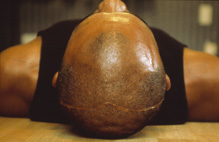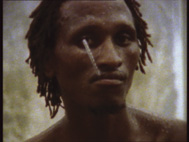Speaking in Tongues
Following his contribution to the Life Live exhibition in 1995, this is
Steve McQueen’s first one-person show in Paris. Since the early 1990s
McQueen’s approach has centered mainly on the making of short films
drawing on a range of media including super 8, 16mm, 35mm and video and
designed to be shown in meticulously arranged installations. Often in
black and white, his first films have an experimental character
referring back to the early days of cinema. Here he presents four recent
installations: radical formal propositions using such varied techniques
as medium close-ups, masking and single frame editing. Specially created
for the exhibition, Once Upon a Time explores the notion of knowledge.
Prepared in association with William J. Clancey, NASA researcher and
advisor to the SETI (Search for Extra Terrestrial Intelligence)
laboratory, and William J. Samarin, linguist and professor emeritus in
the anthropology department at the University of Toronto, the work is
based on images obtained by the 1977 space probe Voyager, launched by
NASA as part of its search for extraterrestrial intelligence. The
outcome is intended to sum up the current state of knowledge on the
subject, against which the artists sets a theoretically unintelligible
glossolalia*.
At the core of the other three installations are the themes of solitude
and isolation:
- using an extremely pared-down monologue, 7th November recounts a
tragic story involving two brothers.
- Girls Tricky shows composer-musician Tricky in a moment of intense
concentration during a recording session.
- Illuminer uses the light emitted by a TV set to reveal the body of the
artist.
In a totally direct way the artist confronts man with the conscious
and unconscious forces that drive him. Without seeking to freeze reality,
he highlights - in the same way as jazz - those moments in which reality
cuts free of consciousness while still continuing to produce meaning.
For this artist reality is more inaccessible than the world of the
imaginary: “Suspense is always with us,” he says. “The unpredictable is
our world.”
* A trance phenomenon, also called “speaking in tongues”: the subject
utters a succession of incomprehensible sounds or words.
|
-
CAMERA
Chang Yung Ho / Wang Jian Wei /
Yang Fudong
CAMERA is an exhibition born of the collaboration between architect
Chang Yung Ho and two of China’s most important contemporary artists,
video artist Yang Fudong and multimedia artist Wang Jian Wei. In its
exploration of the relationship between architecture and video, CAMERA
invites the viewer to test out new approaches to the spatial
presentation of the image.
Playing on the two meanings of camera - “room” in the original Latin
and the camera we know today - Chang Yung Ho has designed four
architectural modules, projection rooms in which exhibition visitors
both look and are looked at. Each of the four spaces is named after a
brand of camera - Polaroid*, Leica*, Nikon* and Seagull* - in reference
to four distinct geographical zones: the United States, Germany, Japan
and China, in that order.
For each module the
architect has had recourse to different materials: sheet metal for Leica,
clear Plexiglas for Polaroid, wood, metal and mirrors for Nikon and rice
paper for Seagull. The new video works by Yang Fudong and Wang Jian Wei
have been specially created for the modules in which they are to be
shown. Living respectively in Shanghai and Peking, these two artists
draw their inspiration from contemporary Chinese society. Wang Jian
Wei’s Square (DV, 13’) and Theater (DV, 20’) show recent social change
as revealed by the collective anonymity of public spaces. In Liu Lan (35
mm, 10’) and Honey (DV, 8’) Yang Fudong’s intimate narrative technique
focuses on the changing definition of the contemporary identity.
* Polaroid, Leica, Nikon and Seagull are registered trademarks.
|



